GMC SIERRA 1998 Manual Online
Manufacturer: GMC, Model Year: 1998, Model line: SIERRA, Model: GMC SIERRA 1998Pages: 452, PDF Size: 23.65 MB
Page 81 of 452
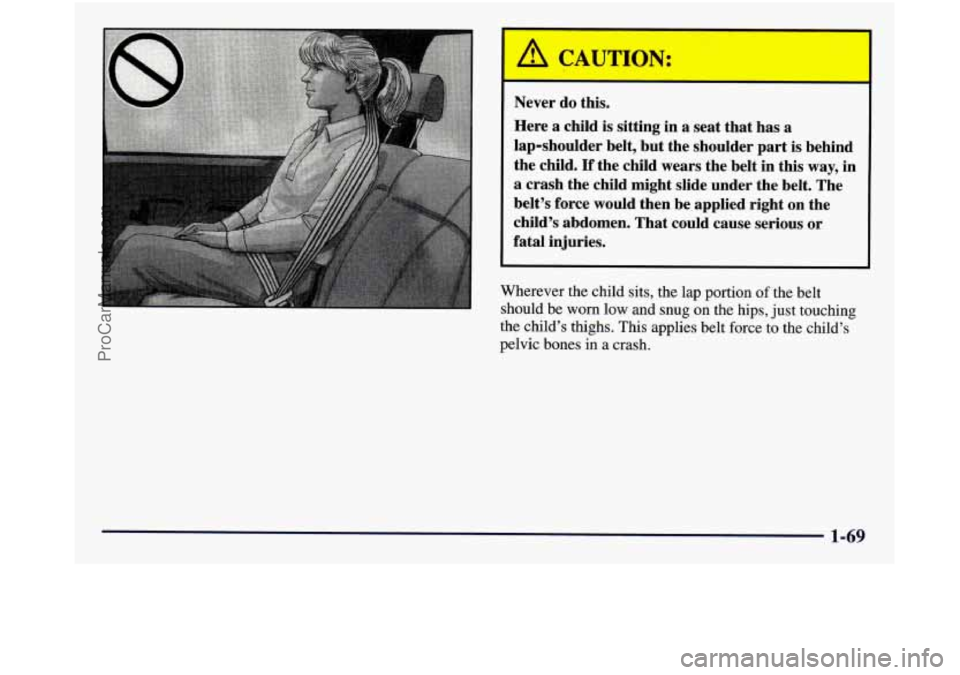
A CAUTION:
Never do this.
Here a child is sitting in a seat that has a
lap-shoulder belt, but the shoulder part is behind
the child.
If the child wears the belt in this way, in
a crash the child might slide under the belt. The
belt’s force would then be applied right on the
child’s abdomen. That could cause serious or
fatal injuries.
Wherever the child sits, the lap portion of the belt
should be worn low and snug on the hips,
just touching
the child’s thighs. This applies belt force
to the child’s
pelvic bones
in a crash.
1-69
ProCarManuals.com
Page 82 of 452
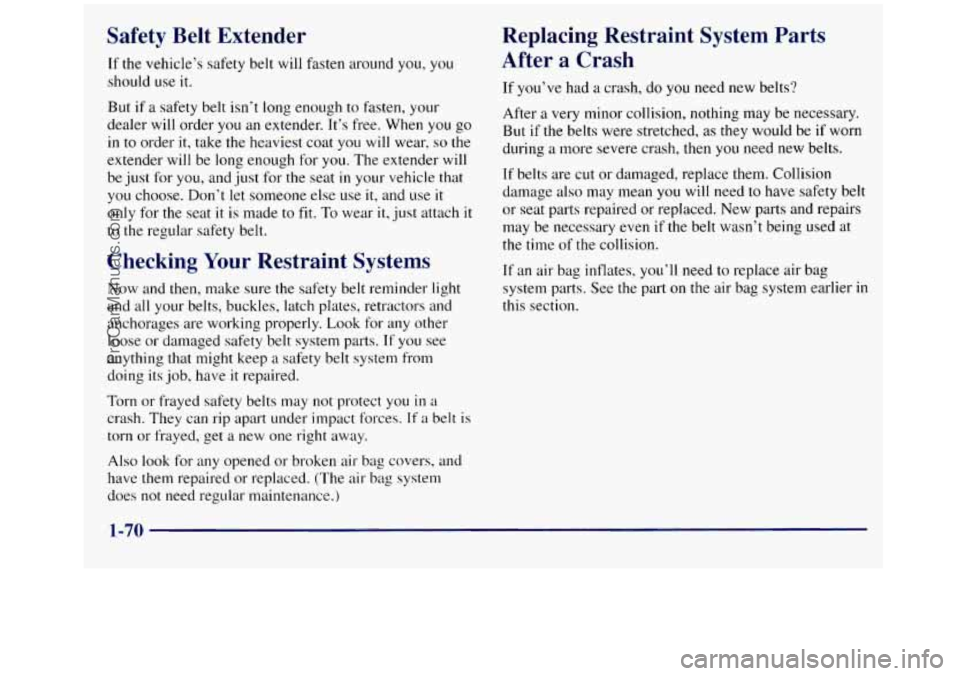
Safety Belt Extender
If the vehicle’s safety belt will fasten around you, you
should use it.
But if a safety belt isn’t long enough to fasten, your
dealer
will order you an extender. It’s free. When you go
in to order it, take the heaviest coat you will wear,
so the
extender will be long enough for you. The extender will
be just for you, and just for the seat
in your vehicle that
you choose. Don’t let someone else use it, and use
it
only for the seat it is made to fit. To wear it, just attach it
to the regular safety belt.
Checking Your Restraint Systems
Now and then, make sure the safety belt reminder light
and
all your belts, buckles, latch plates, retractors and
anchorages are working properly. Look for any other
loose or damaged safety belt system parts. If
you see
anything that might keep
a safety belt system from
doing its job, have
it repaired.
Torn or frayed safety belts may not protect you
in a
crash. They can rip apart under impact forces. If a belt is
torn or frayed, get
a new one right away.
Also look for any opened or broken air bag covers, and
have
them repaired or replaced. (The air bag system
does not need regular maintenance.)
Replacing Restraint System Parts
After a Crash
If you’ve had a crash, do you need new belts?
After
a very minor collision, nothing may be necessary.
But if the belts were stretched, as they would be if worn
during
a more severe crash, then you need new belts.
If belts are cut or damaged, replace them. Collision
damage also may mean you will need
to have safety belt
or seat parts repaired or replaced. New parts and repairs
may be necessary even
if the belt wasn’t being used at
the time
of the collision.
If an air bag inflates, you’ll need to replace air bag
system parts. See the part
on the air bag system earlier in
this section.
1-70
ProCarManuals.com
Page 83 of 452
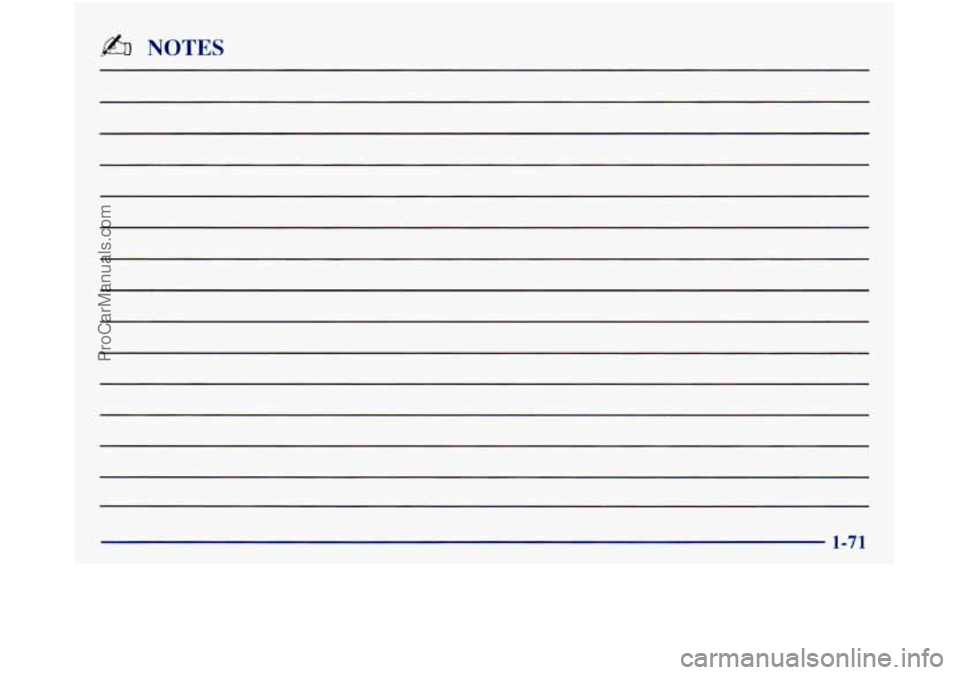
1-71
ProCarManuals.com
Page 84 of 452
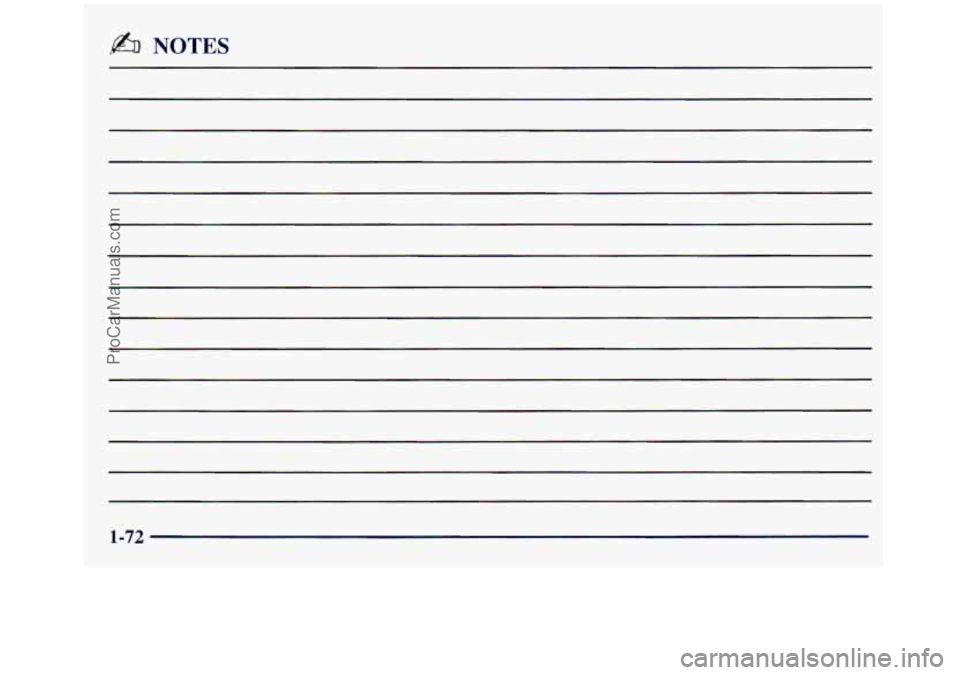
k% NOTES
1-72
ProCarManuals.com
Page 85 of 452
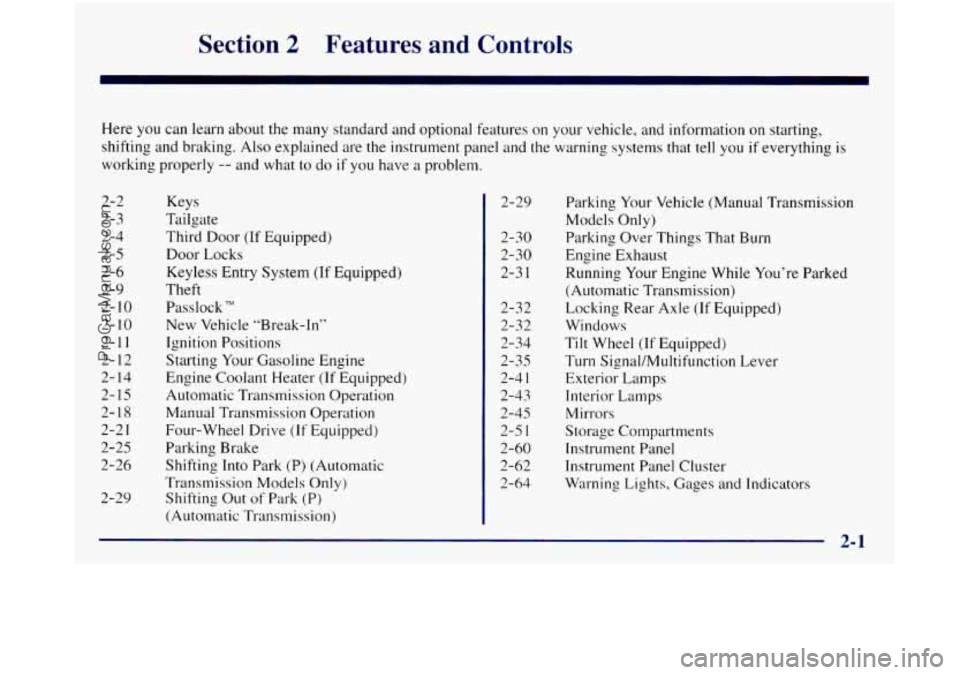
Section 2 Features and Controls
Here you can learn about the many standard and optional features on your vehicle, and information on starting,
shifting and braking. Also explained are the instrument panel and
the warning systems that tell you if everything is
working properly
-- and what to do if you have a problem.
2-2
2-
3
2-4 2-5
2-6
2-9
2-
10
2- 10
2-1 1
2-12
2- 14
2-15
2-18
2-2
I
2-25
2-26
2-29 Keys
Tailgate
Third Door
(If Equipped)
Door Locks
Keyless Entry System (If Equipped)
Theft
PasslockTM
New Vehicle ”Break-In”
Ignition Positions
Starting Your Gasoline Engine
Engine Coolant Heater (If Equipped) Automatic Transmission Operation
Manual Transmission Operation Four-wheel Drive
(If Equipped)
Parking Brake
Shifting Into Park
(P) (Automatic
Transmission Models
Only)
Shifting Out of Park (P)
(Automatic Transmission) 2-29
2-30
2-30
2-3 1
2-32
2-32
2-34
2-35
2-4
1
2-43
2-45
2-5
1
2-60
2-62
2-64 Parking
Your Vehicle (Manual Transmission
Models
Only)
Parking Over Things That Burn
Engine Exhaust
Running Your Engine While You’re Parked
(Automatic Transmission)
Locking Rear Axle (If Equipped)
Windows
Tilt Wheel (If Equipped)
Turn Signal/Multifunction Lever
Exterior Lamps
Interior Lamps Mirrors
Storage Compartments
Instrument Panel
Instrument Panel Cluster
Warning Lights, Gages and Indicators
ProCarManuals.com
Page 86 of 452
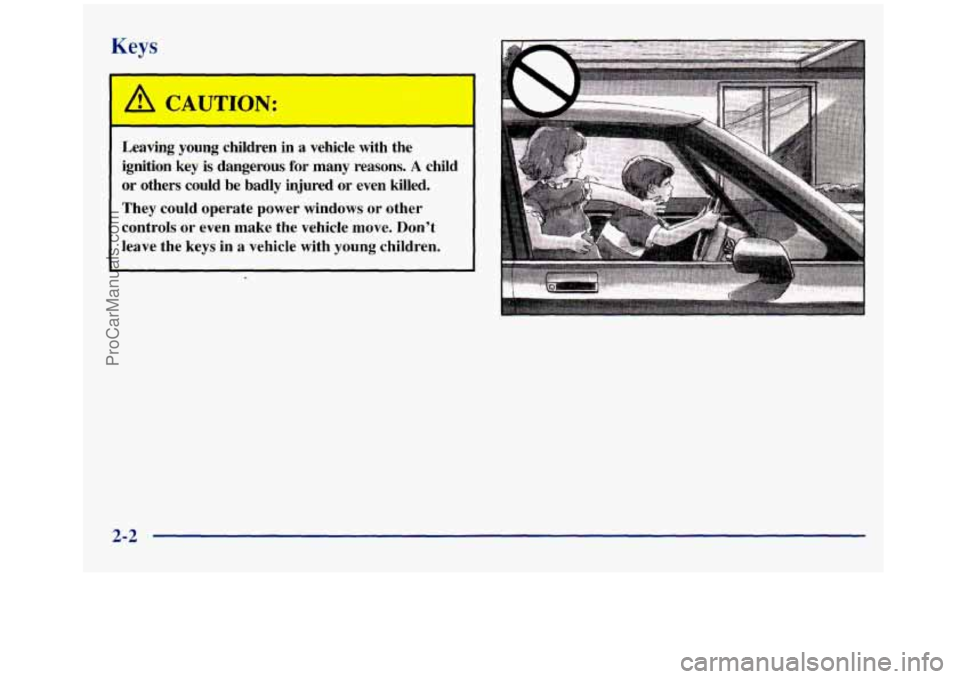
Keys
Leaving young children in a vehicle with the
ignition key
is dangerous for many reasons. A child
or others could be badly injured or even killed.
They could operate power windows
or other
controls or even make the vehicle
move. Don't
leave the keys in
a vehicle with young children.
2-2
ProCarManuals.com
Page 87 of 452
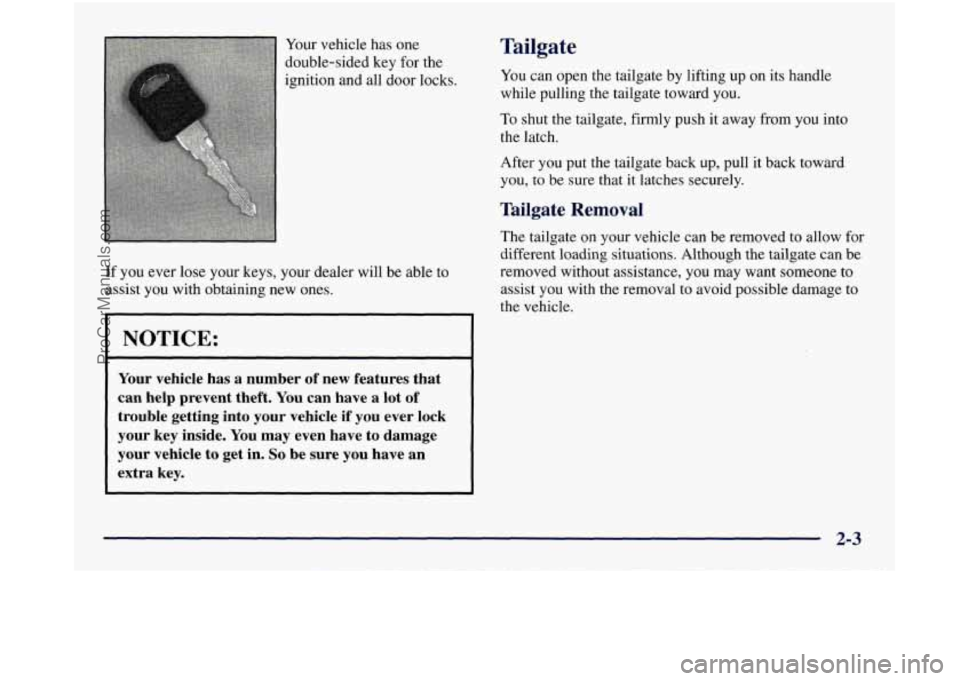
Your vehicle has one
double-sided key for the
ignition and all door locks.
If you ever lose your keys, your dealer will be able to
assist you with obtaining new ones. Tailgate
You can open the tailgate by lifting up on its handle
while pulling the tailgate toward you.
To shut the tailgate, firmly push it away from you into
the latch.
After you put the tailgate back up, pull it back toward
you,
to be sure that it latches securely.
Tailgate Removal
The tailgate on your vehicle can be removed to allow for
different loading situations. Although the tailgate can be
removed without assistance, you may want someone to
assist you with the removal to avoid possible damage to
the vehicle.
NOTICE:
' Your vehicle has a number of new features that
can help prevent theft.
You can have a lot of
trouble getting into your vehicle if you ever lock
your key inside.
You may even have to damage
your vehicle to get in.
So be sure you have an
extra key.
~. _~- -- . ~. - ~
2-3
ProCarManuals.com
Page 88 of 452
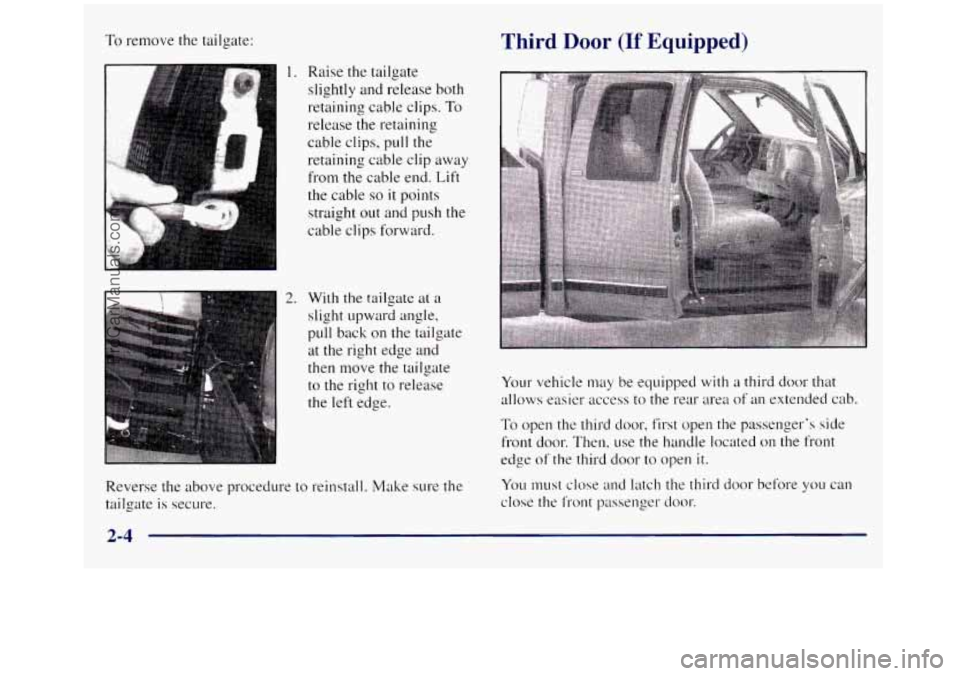
To remove the tailgate:
2.
Raise the tailgate
slightly and release both
retaining cable clips.
To
release the retaining
cable clips, pull the
retaining cable clip away
from the cable end. Lift
the cable
so it points
straight out and push the
cable clips forward.
With the tailgate at a
slight upward angle.
pull back on the tailgate
at the right edge
and
then move the tailgate
to the right
to release
the left edge.
Re.verse the above procedure
to reinsla
tailgate is secure. dl. Make sure t :he
Third Door (If Equipped)
Your vehicle may be equipped with a third door that
allows easier access
to the rear area of an extended cab.
To open the third door, first open the passenger’s side
front door. Then, use the handle located on the front
edge
of the third door to open it.
You must close and latch the third
door before you can
close the front passenger door.
2-4
ProCarManuals.com
Page 89 of 452
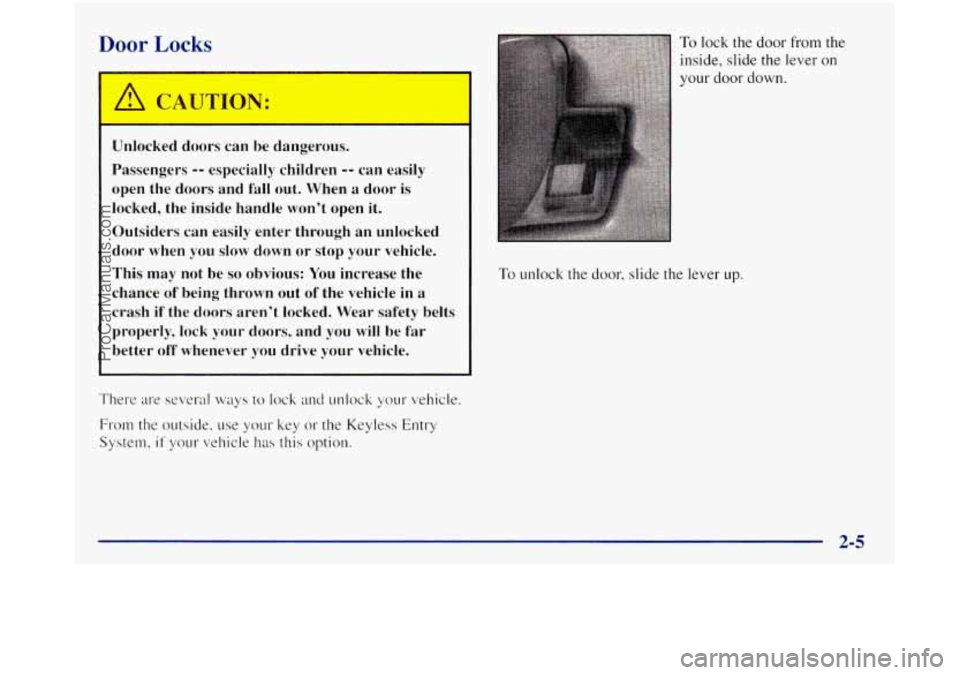
Door Locks
A CAUTION:
Unlocked doors can be dangerous.
Passengers
-- especially children -- can easily
open the doors and fall out. When
a door is
locked, the inside handle won't open it.
Outsiders can easily enter through an unlocked
door when
you slow down or stop your vehicle.
This may not be
so obvious: You increase the
chance
of being thrown out of the vehicle in a
crash if the doors aren't locked. Wear safety belts
properly, lock your doors, and you
will be far
better off whenever you drive your vehicle.
There are several cc.ays to lock and unlock your vehicle.
From the outside. use your key or the Keyless Entry
System.
if your \:ellick has this option.
To lock the door from the
inside, slide
the lever on
your door down.
To unlock the door. slide the lever up.
2-5
ProCarManuals.com
Page 90 of 452

~ Power Door Locks (If Equipped)
Press the bottom of the
power door lock switch,
marked
LOCK, on either
front door to lock all the
doors at once. Press the
ribbed side
of the switch to
unlock all the doors at once.
Leaving Your Vehicle
If you are leaving the vehicle, take your keys, open your
door and set the locks from inside. Then get out and
close the door.
Keyless Entry System (If Equipped)
If your vehicle has this option, you can lock and unlock
your doors from about
3 feet (1 m) up to 30 feet (9 m)
away using the remote keyless entry transmitter supplied
with your vehicle. Your
interior lamps will be illuminated for a set period
of time when the transmitter signal is received by the
Keyless Entry System.
In addition, your vehicle’s horn
will chirp if you press the
LOCK button twice, to let you
know that the doors have locked.
Your keyless entry system operates on a radio frequency
subject to Federal Communications Commission (FCC)
Rules and with Industry Canada.
This device complies with
Part 15 of the FCC Rules.
Operation is subject to the following two conditions:
(1) this device may not cause harmful interference, and
(2) this device must accept any interference received,
including interference that may cause undesired operation.
This device complies with RSS-210
of Industry Canada.
Operation is subject to the following two conditions:
(1) this device may not cause interference, and
(2) this
device must accept any interference received, including
interference that may cause undesired operation
of
the device.
Changes or modifications to this system by other than an
authorized service facility could void authorization
to
use this equipment.
2-6 -
ProCarManuals.com